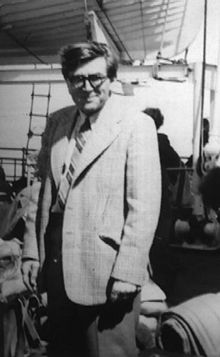Henryk Zygalski

(bornJuly 15, 1908inPosen, †August 30, 1978inPlymouth) was aPolish mathematicianandcryptologist.
After studying mathematics at the University of Poznan , he worked from 1933 together with his colleagues Marian Rejewski and Jerzy Różycki as a cryptanalyst in the Polish decryption center, the Biuro Szyfrów (German: "Chiffrenbüro"), on deciphering the radio messages sent by the German military encrypted using their key machine Enigma .
A special task that had to be solved during the deciphering was to determine the correct roller position and roller position, which the Germans had used to encrypt a radio message. For this purpose, special perforated sheets provided valuable help, which were devised by Zygalski in 1938 especially for this purpose and which are named after him as Zygalski perforated sheets .
In 1939, in view of the increasing threat to Poland, the Polish leadership decided to use the methods and equipment that had been successfully developed since 1932 and that had been used to decipher the messages encrypted by the German Reichswehr and later by the Wehrmacht with the help of the Enigma , to pass on to the French and British allies. On July 26th and 27th, 1939 the legendary secret meeting of French, British and Polish code breakers took place in the Kabaty forest of Pyry , just under 20 km south of Warsaw, where they presented their Enigma replicas and their cryptanalytic machines to the amazed British and French . like Cyclometer and Bomba , presented and revealed their methodologies. With this boost, the British code breakers in Bletchley Park, England, were able to launch another attack on the German machine at the outbreak of war, which subsequently enabled them to decipher the encrypted German radio messages almost continuously.
Shortly afterwards, in September 1939, after the German attack on Poland , he had to leave his country, fled via Romania and initially found asylum in France, where he, together with many of his colleagues from the BS in " PC Bruno ", a secret intelligence service The Allied establishment near Paris, was able to continue its successful cryptanalytic work against the Enigma. With the German offensive against France in June 1940, he had to flee again from the advancing Wehrmacht and found a new location (camouflage name: "Cadix" ) near Uzès in the free southern zone of France .
He later went into exile in England and stayed there after the war, where he found work as a math teacher at a school. Shortly before his death, he was officially honored for his services in breaking the Enigma and received an honorary doctorate from the Polish University of Exile . Henryk Zygalski died in Plymouth on August 30, 1978 and was buried in London . In his honor, a memorial plaque was placed on Pilsudski Square in Warsaw . In 2007, on the 75th anniversary of the first deciphering of the Enigma , the cryptologist memorial (Polish: Pomnik kryptologów ) dedicated to him and his two colleagues was unveiled in front of the Residential Palace in Poznan .
literature
- Chris Christensen: Review of IEEE Milestone Award to the Polish Cipher Bureau for `` The First Breaking of Enigma Code '' . Cryptologia . Rose-Hulman Institute of Technology. Taylor & Francis, Philadelphia PA 39.2015,2, pp. 178-193. ISSN 0161-1194 .
- Rudolf Kippenhahn : Encrypted messages, secret writing, Enigma and chip card . Rowohlt, Reinbek near Hamburg 1999. ISBN 3-499-60807-3 .
- Władysław Kozaczuk & Jerzy Straszak: Enigma - How the Poles Broke the Nazi Code . Hyppocrene Books, New York 2004. ISBN 0-7818-0941-X .
- Marian Rejewski: An Application of the Theory of Permutations in Breaking the Enigma Cipher . Applicationes Mathematicae, 16 (4), 1980, pp. 543-559 PDF; 1.7 MB .
- Gordon Welchman : From Polish Bomba to British Bombe: The Birth of Ultra . Intelligence and National Security, 1986.
Web links
- CV (English). Retrieved April 21, 2015
- Secret Operation Wicher - Description of the Polish contribution to the breaking of the Enigma
- Explanation of how the Zygalski perforated sheets work (in English)
- View of the Cryptologist Monument in Poznan . Retrieved February 23, 2016
Individual evidence
- ↑ a b Ralph Erskine: The Poles Reveal their Secrets - Alastair Dennistons's Account of the July 1939 Meeting at Pyry . Cryptologia. Rose-Hulman Institute of Technology. Taylor & Francis, Philadelphia PA 30.2006,4, p. 294
- ↑ Marek Grajek : Monument in Memoriam of Marian Rejewski, Jerzy Różycki and Henryk Zygalski Unveiled in Poznań , Cryptologia, 32: 2, 2008, pp. 101-103, doi : 10.1080 / 01611190801916634
| personal data | |
|---|---|
| SURNAME | Zygalski, Henryk |
| BRIEF DESCRIPTION | Polish mathematician and cryptanalyst |
| DATE OF BIRTH | July 15, 1908 |
| PLACE OF BIRTH | Poses |
| DATE OF DEATH | August 30, 1978 |
| Place of death | Plymouth |



